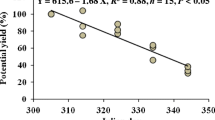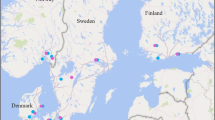Abstract
G2 Blackspot Manager, the second generation (G2) of Blackspot Manager model, predicts disease severity and yield loss in addition to quantified release of seasonal ascospores in relation to ascochyta blight on field pea. The model predicts the disease severity with respect to the expected exposure of field pea crop to ascospores of D. pinodes, with yield loss subsequently related to the disease severity. Both the relationships were developed using published and unpublished data under southern Australian conditions. The model has been used as a decision support tool for developing a field pea sowing guide considering weather-based disease risk and abiotic risk. This paper presents the field pea sowing guide for South Australia, Victoria and Western Australia for the 2010 season and compares it with 2009. The guide is dynamic as the disease severity changes with seasonal weather conditions and is updated weekly starting around mid-April, being delivered principally via the web (http://www.agric.wa.gov.au/cropdisease). The paper also discusses other means of communicating the guide to the stakeholders of southern Australia.




Similar content being viewed by others

References
ABARE (2010) Australian crop report. Australian Bureau of Agricultural and Resource Economics, No. 153, February 2010
Bretag TW (1991) Epidemiology and control of ascochyta blight of field peas. PhD Thesis, La Trobe University, Australia
Bretag TW, Keane PJ, Price TV (1995) Effect of ascochyta blight on grain yield of field peas (Pisum sativum L.) grown in southern Australia. Aust J Exp Agric 35:531–536
Bretag TW, Keane PJ, Price TV (2000) Effect of sowing date on the severity of ascochyta blight in field peas (Pisum sativum L.) grown in Wimmera region of Victoria. Aust J Exp Agric 40:1113–1119
Bretag TW, Keane PJ, Price TV (2006) The epidemiology and control of ascochyta blight in field peas: a review. Aust J Agric Res 57:883–902
Davidson JA, Hartley D, Priest M, Krysinska-Kaczmarek K, Herdina MK, McKay A, Scott ES (2009) A new species of Phoma causes ascochyta blight symptoms of field peas (Pisum sativum) in South Australia. Mycologica 101:120–128
Hawthorne W, Davidson JA, McMurray L, Armstrong E, MacLeod W, Bretag TW (2003) Field pea disease management strategy for southern and western regions, Disease management guide series, Pulse Australia, Sydney, Australia
Jeffrey SJ, Carter JO, Moodie KB, Beswick AR (2001) Using spatial interpolation to construct a comprehensive archive of Australian climate data. Environ Modell Softw 16:309–330
McDonald GK, Peck D (2009) Effects of crop rotation, residue retention and sowing time on the incidence and survival of ascochyta blight and its effect on grain yield of field peas (Pisum sativum L.). Field Crops Res 111:11–21
McMurray LS, Davidson JA, Lines MD, Leonforte AL, Salam MU (2011) Combining management and breeding advances to improved field pea (Pisum sativum) grain yields under changing climatic conditions in south-eastern Australia. Euphytica. doi:10.1007/s10681-011-0362-9
Peever TL, Barve MT, Stone LJ, Kaiser WJ (2007) Evolutionary relationships among Ascochyta species infecting wild and cultivated hosts in legume tribes Cicereae and Vicieae. Mycologia 99:59–77
Salam MU, Galloway J, Payne P, MacLeod WJ, Diggle AJ (2006) Field pea blackspot disease in 2005: prediction versus reality. In 2006 ‘Lupins and Pulses Updates, Agribusiness Crop Updates 2006’. Department of Agriculture, Western Australia, pp 91–93
Salam MU, MacLeod WJ, Maling T, Prichard I, Seymour M, Barbetti MJ (2011a) A meta-analysis of severity and yield loss from ascochyta blight on field pea in Western Australia. Australas Plant Pathol. doi:10.1007/s13313-011-0034-1
Salam MU, Galloway J, MacLeod WJ, Davidson JA, Seymour M, Prichard I, Salam KP, Diggle AJ, Maling T (2011b) G1 Blackspot Manager model predicts the maturity and release of ascospores in relation to ascochyta blight of field pea. Australas Plant Pathol. doi:10.1007/s13313-011-0035-0
Sharma DL, D’Antuono MF, Anderson WK, Shackley BJ, Zaicou-Kunesch CM, Amjad M (2008) Variability of optimum sowing time for wheat yield in Western Australia. Aust J Agric Res 59:958–970
Acknowledgements
We thank the Grains Research and Development Corporation (GRDC) of Australia for financial assistance in this work.
Author information
Authors and Affiliations
Corresponding author
Rights and permissions
About this article
Cite this article
Salam, M.U., MacLeod, W.J., Pritchard, I. et al. G2 Blackspot Manager model to guide field pea sowing for southern Australia in relation to ascochyta blight disease. Australasian Plant Pathol. 40, 632–639 (2011). https://doi.org/10.1007/s13313-011-0044-z
Received:
Accepted:
Published:
Issue Date:
DOI: https://doi.org/10.1007/s13313-011-0044-z



